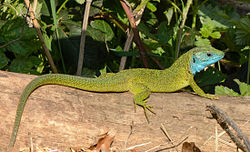| Lacerta Temporal range: Miocene—Present, | |
|---|---|
 | |
| Sand lizard (Lacerta agilis) | |
| Scientific classification | |
| Kingdom: | Animalia |
| Phylum: | Chordata |
| Class: | Reptilia |
| Order: | Squamata |
| Suborder: | Lacertoidea |
| Family: | Lacertidae |
| Tribe: | Lacertini |
| Genus: | Lacerta Linnaeus, 1758 |
| Type species | |
| Lacerta agilis | |
| Species | |
Ten, see text. | |
 | |
| Modern range of Lacerta species: L. agilis L. bilineata L. citrovittata L. diplochondrodes L. media L. pamphylica L. schreiberi L. strigata L. trilineata L. viridis | |
Lacerta is a genus of lizards of the family Lacertidae.











